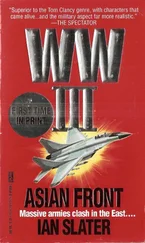“Don’t get out,” Tayama told Yoko quietly, holding her hand tightly. “I don’t see his boat. We’ll go on to Waikiki and I’ll call his home. He might have anchored somewhere on the island’s northwest side, which is better anyway. It’s closer to Kauai.”
“Ha!” said their nervous neighbor. “All probably drunk. Saturday-night fling. Ha!”
Yoko smiled weakly. Farther on, at the stop a block from the pink Royal Hawaiian, which was one of only a few hotels near what is now the International Market Place, they alighted so that Tayama could use the pay phone in the plush lobby of the hotel. One of the American guests coming out of the hotel glowered at them, a bellboy trying to get the crowd waiting for the phone to form a line along one side of the lobby, where guests, early risers for a Sunday, were spilling out onto Kalakaua Avenue in confused alarm. Someone was yelling that Schofield Army Barracks were also under attack, someone else claimed that a Japanese submarine had been depth-charged off the entrance to Pearl Harbor. Perhaps, Tayama thought, that had been the first explosion he’d heard on the way to the stall.
Tayama and Yoko, avoiding the stares of guests coming and going through the lobby, kept their eyes fixed on the phone queue ahead of them, the hostility in the air so intense that for the first time in her life Yoko was aware that she could actually feel waves of hatred directed at her.
“Hey, Omura!”
Tayama turned his head back toward the hotel’s entrance.
“Come here!” It was the Naval intelligence officer, Lieutenant Suzuki.
Even before Tayama and Yoko stepped up into the back of the open khaki-green three-ton Army truck, they saw that their neighbor from the bus was among the dozen or so Japanese-Americans who had already been rounded up.
“Think we’ll be all right?” Tayama asked his neighbor as he sat down on the truck’s hard seat.
“Shut your face, Omura!” shouted Suzuki.
On the third night of internment, as the moon slipped temporarily behind thick cumulus, Yoko, blindfolded, was taken by two men to a small, pitch-dark shed toward the rear of the camp. One of the men savagely beat her when she tried to protest, her blindfold slipping. He shoved an oily wad of cloth down her throat. After the rape, they told her if she reported it to anyone, her “Jap boyfriend” would be dragged out of the men’s barracks and would “get the shit kicked out of him.”
One of her attackers, though she could see neither clearly, given the darkness, was a black man, and the other sounded like Lieutenant Suzuki.
Bleeding, her face throbbing with pain, Yoko crept back to the women’s barracks and wept quietly in her bunk, determined not to raise a fuss, put Tayama in danger. The thought that Suzuki, a fellow Japanese-American, might have been one of the men seemed unthinkable until she recalled reports she’d heard of how in Korea and China some of the POWs captured by the Japanese Imperial Army had turned collaborationist, and had become more cruel toward their own kind than their Japanese captors.
Four days later she saw Suzuki enter the camp between two tall white guards and noticed, with satisfaction, that the naval intelligence officer’s former swaggering self-confidence had been replaced now with a stare of apprehension.
A few days later the rumor was that while Suzuki was still nominally a lieutenant in U.S. Naval Intelligence, he was being used not as an interrogator but merely as an interpreter and, as a further insult, in the women’s, rather than the men’s, barracks. He too was clearly under suspicion. She also saw Tayama for the first time since they had been herded into the Army truck. Not being married they, like all the other single men and women, had been segregated and couldn’t speak to each other. But Tayama didn’t have to be told what had happened to her. He could see the dark bruising on her face and arms, her swollen lips, and while he said nothing, the veins in his neck suddenly became taut, pulsating with rage at what he knew must have happened.
From that moment on, Tayama Omura’s one-time admiration for America and Americans froze and transformed itself into a hatred that would never leave him, a hatred increasingly rationalized by the way in which the innocent Nisei and Japanese immigrants in Hawaii would be treated for the duration of the war. Never mind the fact that later Nisei volunteers, many of them who, like Suzuki, had been either downgraded or dismissed outright from the National Guard and who were prevented from joining any of the armed services, eventually formed two segregated Nisei regiments and that one of these units, the 442nd, went into action in Europe, becoming the most decorated combat unit in the history of the United States. Or that one of the Nisei veterans, whose life was saved by a field blood transfusion from a member of a segregated black combat unit and who lost an arm during battle, was not only decorated but later became Hawaii’s first senator. For Tayama Omura all that mattered was that his beloved Yoko had been raped by an American.
Six weeks after the assault, Yoko realized her ill fortune had become compounded and drastically exacerbated. She was pregnant, so now she lived with the ever-growing fear — one of the worst to befall a Nisei — that she might be carrying a black man’s child. Not even white Hawaiians, she knew, could live with what was then considered a shame worse than death. In Yoko’s Japan it had always been accepted that black Americans were no better than savages. They were considered highly potent sexually but almost as low on the evolutionary ladder as the Chinese, those Chinese who had fled their turbulent country to Hawaii now taking a special, if quiet, delight in seeing the Nisei rounded up, receiving what the Chinese deemed the Nisei’s comeuppance. It was only fitting, from the Chinese view, that the Japanese pay not only for their attack against America but also for their continuing invasion of the Chinese homeland, memories of Nippon’s aggression in Manchuria and the rape of Nanking still fresh in the minds of many Chinese who had fled their homeland to escape the Japanese.
If there was any chance of Tayama’s hatred of the U.S. fading in the future, it was dashed forever on the evening of Sunday, March 15, 1942, when Yoko, despite the prohibitions of her deep Shinto upbringing, tried to abort her pregnancy with a coat hanger in the women’s barracks washroom. Septicemia quickly set in and soon she went into shock. She was rushed to Queen’s Hospital but “expired following abortion of Caucasian/Asian fetus,” as the coroner’s report put it, “at 0315, March 17/42.”
From that day on, Tayama Omura, his hatred further fueled later by the fact that both his sisters were killed, along with tens of thousands of his fellow Japanese, by the A-bomb the Americans dropped on Nagasaki, which ended the war, became an implacable foe of the United States. The subsequent apologies by the U.S. government years later for its wartime treatment of Americans of Japanese descent did nothing to mitigate his hatred, so that during the Korean War of the early 1950s when he was approached by North Korea’s RDEI, Research Department for External Intelligence, he was ripe for recruitment to spy on America’s strategically vital Pacific base in Hawaii. If revenge hadn’t been motivation enough, he was brusquely informed by the Kempei Tai that his two brothers, who had surrendered with the other Japanese divisions in Korea at World War II’s end, might be eventually freed and repatriated by Pyongyang. But it was an unnecessary inducement, for what had previously been a resented task of espionage, through blackmail, against the Americans had now become a zealous and ongoing revenge for the death of his beloved Yoko and his two sisters.
Читать дальше












